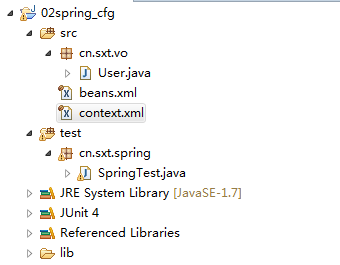java之spring之配置讲解
首先目录结构如下:

1. User.java
1 package cn.sxt.vo; 2 3 import java.util.Date; 4 5 public class User { 6 7 private String name; 8 private int age; 9 private Date birthday; 10 public String getName() { 11 return name; 12 } 13 public void setName(String name) { 14 this.name = name; 15 } 16 public int getAge() { 17 return age; 18 } 19 public void setAge(int age) { 20 this.age = age; 21 } 22 public Date getBirthday() { 23 return birthday; 24 } 25 public void setBirthday(Date birthday) { 26 this.birthday = birthday; 27 } 28 @Override 29 public String toString() { 30 return "User [name=" + name + ", age=" + age + ", birthday=" + birthday + "]"; 31 } 32 }
2. beans.xml
<?xml version="1.0" encoding="UTF-8"?> <beans xmlns="http://www.springframework.org/schema/beans" xmlns:xsi="http://www.w3.org/2001/XMLSchema-instance" xsi:schemaLocation="http://www.springframework.org/schema/beans http://www.springframework.org/schema/beans/spring-beans.xsd"> <!-- import用于导入其他配置信息 主要的作用就是团队协作开发使用 --> <import resource="context.xml"/> </beans>
3. context.xml
<?xml version="1.0" encoding="UTF-8"?> <beans xmlns="http://www.springframework.org/schema/beans" xmlns:xsi="http://www.w3.org/2001/XMLSchema-instance" xsi:schemaLocation="http://www.springframework.org/schema/beans http://www.springframework.org/schema/beans/spring-beans.xsd"> <description> 描述信息 </description> <!-- bean 表示java对象 id是对象的标识符,在容器中唯一。通过标识符可以从容器中获取对象。 name 如果没有配置id,那么name将作为对象的标识符,如果配置了id,那么是id的别名。 可以同时设置多个别名,多个别名之间用分隔符(逗号,空格,分号)分割 class 类所在的完全限定名=包名+类名; --> <bean id="user" name="u1,u2 u3;u4" class="cn.sxt.vo.User"> <!-- property 表示类的属性设置,需要为其提供set方法,以便将值设置到对象上。 name 表示set方法去掉set后的名称 value 设置属性的值,value可以将基本数据类型和String设置到属性上。 如果值是一个对象 需要使用ref属性引用 --> <property name="name" value="张三疯"/> <property name="age" value="22"/> </bean> <!-- 设置别名 通常设置一个 name表示要设置别名的对象的标识符 alias 表示 设置的别名名称 --> <alias name="user" alias="u5"/> </beans>
4. SpringTest.java
package cn.sxt.spring; import org.junit.Test; import org.springframework.context.ApplicationContext; import org.springframework.context.support.ClassPathXmlApplicationContext; import cn.sxt.vo.User; public class SpringTest { @Test public void testHello(){ ApplicationContext ac = new ClassPathXmlApplicationContext("beans.xml"); User u=(User)ac.getBean("u4"); System.out.println(u); } }






【推荐】国内首个AI IDE,深度理解中文开发场景,立即下载体验Trae
【推荐】编程新体验,更懂你的AI,立即体验豆包MarsCode编程助手
【推荐】抖音旗下AI助手豆包,你的智能百科全书,全免费不限次数
【推荐】轻量又高性能的 SSH 工具 IShell:AI 加持,快人一步
· AI与.NET技术实操系列:基于图像分类模型对图像进行分类
· go语言实现终端里的倒计时
· 如何编写易于单元测试的代码
· 10年+ .NET Coder 心语,封装的思维:从隐藏、稳定开始理解其本质意义
· .NET Core 中如何实现缓存的预热?
· 分享一个免费、快速、无限量使用的满血 DeepSeek R1 模型,支持深度思考和联网搜索!
· 基于 Docker 搭建 FRP 内网穿透开源项目(很简单哒)
· 25岁的心里话
· ollama系列01:轻松3步本地部署deepseek,普通电脑可用
· 按钮权限的设计及实现